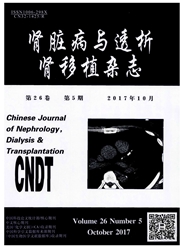

 中文摘要:
中文摘要:
目的:血栓性微血管病(TMA)作为一种病理表现,往往预示着患者长期肾脏预后不良;寻找非创伤性的TMA诊断方法,对于临床评估肾脏损伤具有重要的意义. 方法:入选220例临床疑诊TMA的患者,根据肾活检结果,分为TMA组(n=51)和非TMA组(n=169).比较两组实验室检查指标的差异,依据Logistic回归,建立TMA诊断模型.进一步入选临床疑诊的另一组TMA患者(n=46)及临床疑诊合并TMA的系统性红斑狼疮(SLE)患者(n=157),验证和评估该模型诊断TMA的价值. 结果:TMA组和非TMA组随访12月的肾存活率有显著差异,TMA组患者肾脏预后更差(P=0.015).TMA组的血小板(PLT)、血红蛋白(Hb)、乳酸脱氢酶(LDH)、血清肌酐(SCr)、血管性血友病因子裂解蛋白酶13(ADAMTS13)活性和血栓调节蛋白(THBD),与非TMA组有统计学差异(均P<0.05).以这6个指标纳入多因素logistic回归分析,结果表明,SCr、PLT、LDH和ADAMTS13活性为肾脏TMA病变的有效预测指标(均P<0.05),并据此,建立Logistic回归方程.Hosmer-Lemeshow检验的拟合良好(P=0.489).在46例临床疑诊TMA的独立患者中验证,ROC曲线下面积(AUC)为0.815(P<0.001);在157临床疑诊TMA的SLE患者中,AUC为0.852(P<0.001),验证该模型具有较好的临床诊断TMA的价值. 结论:基于PLT、LDH、SCr和ADAMTS13活性建立了非活检的TMA诊断模型,对于临床疑诊患者有较高的诊断价值,具有较好的临床应用前景.
 英文摘要:
英文摘要:
Objective:Thrombotic microangiopathy (TMA) is a pathologic lesion and predicts a worse prognosis in kidney. Microangiopathic hemolytic anemia and thrombocytopenia are often suggestive of this lesion, but the standard diagnostic test is still a renal biopsy. The objective of this study is to develop a noninvasive panel and validate its value of diagnosing TMA. Methodology:Two hundred twenty suspected patients were divided into TMA group (n = 51 ) and non- TMA group (n= 169) according to renal biopsy results. They were used to develop a diagnostic panel of TMA by binary logistic gression. The internal validation were then performed, including 46 independent patients and 157 patients with systemic lupus erythematosus (SLE) and the diagnostic value for TMA lesion was further evaluated. Results: The patients with TMA presented worse renal outcome after 12 months of follow-up (P = 0. 015 ), compared with those without TMA. A panel of 4 variables-levels of serum creatinine, platelets, LDI-I and ADAMTS13 activity discriminated between patients with TMA and those without ( area under the curve [ AUC ], 0. 800; 95% confidence interval [ CI ], 0. 723 to 0. 877;P〈0. 001) :logitP = -0. 371-0. 002×ADAMTS13activity+0. 140×SCr+0. 004×LDH-0. 010xPLT. This panel was internally validated in 46 independent patients (AUC ,0. 815 ;P〈0. 001 ). The Hosmer-Lemeshow test indicated a good fit (P= 0. 489). In the set of suspected patients with SLE, the AUCs were 0. 852 (P〈0. 001 ). Conclusion: A validated panel including serum creatinine, platelets, LDH and ADAMTS13 activity may be one of noninvasive utility in informing clinicians TMA diagnosis and and patients.
 同期刊论文项目
同期刊论文项目
 同项目期刊论文
同项目期刊论文
 期刊信息
期刊信息
